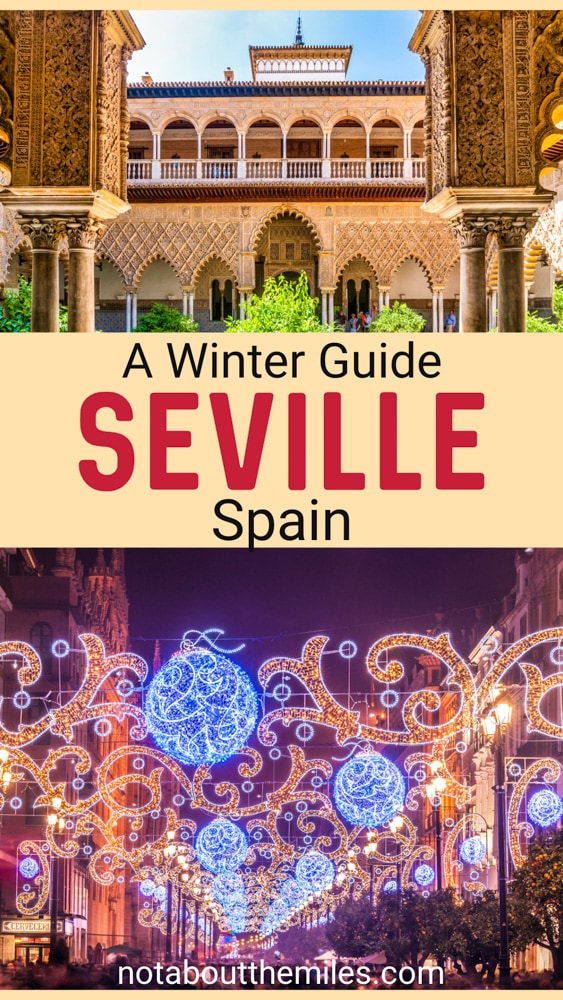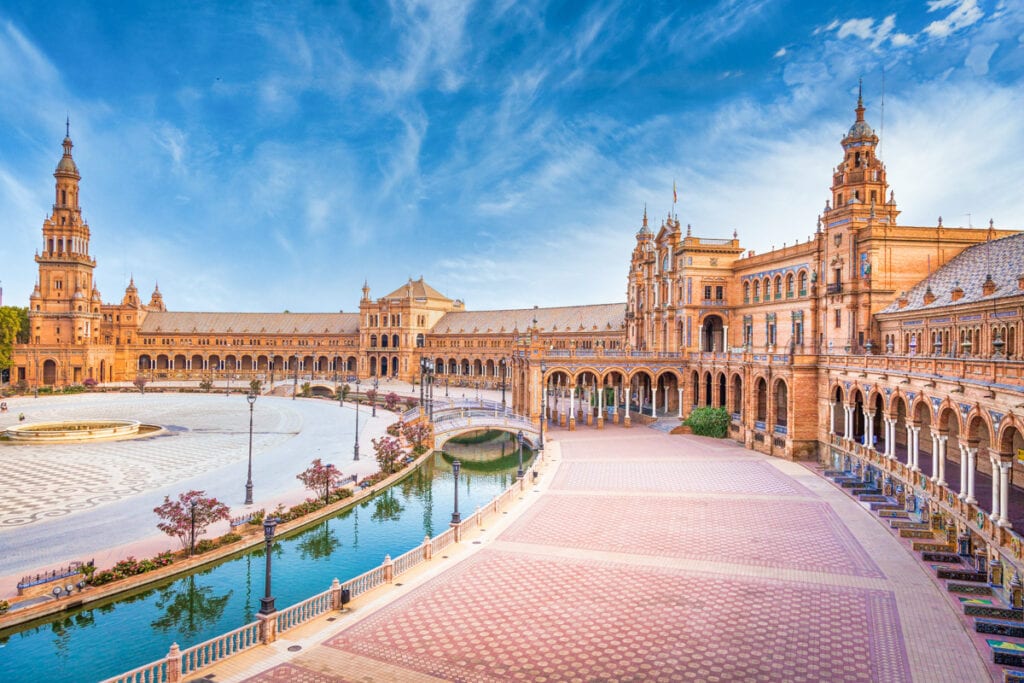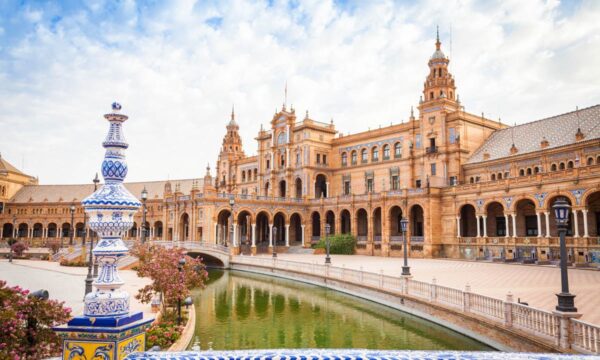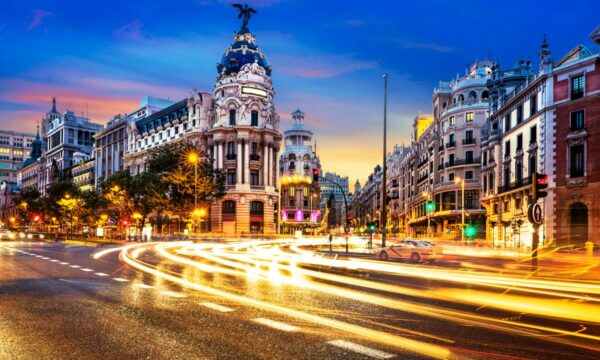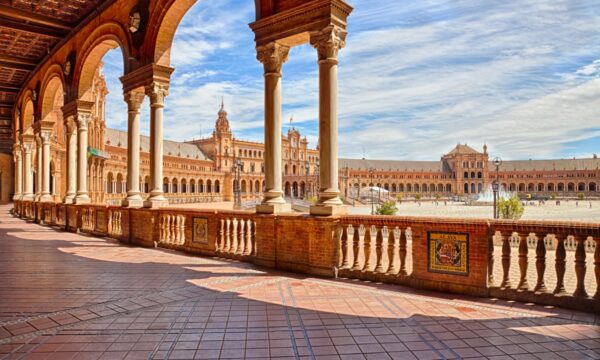Seville in winter makes for a magical break. While most of Europe is bone-chilling cold and buried in snow in the winter, Seville is usually sunny and mild.
The Andalusian city of Seville is known for tapas and flamenco, beautiful architecture and gardens, pretty streets fringed with orange trees, and a vibrant vibe that’s classic southern Spain.
But Seville also known for its sweltering summers!
By visiting Seville in winter, you not only enjoy pleasant daytime temperatures, you also escape the crowds of the high season. Plus, accommodation is much less expensive in the winter!
Ready to plan a winter vacation in Seville? Read on to discover what to do in winter in Seville!
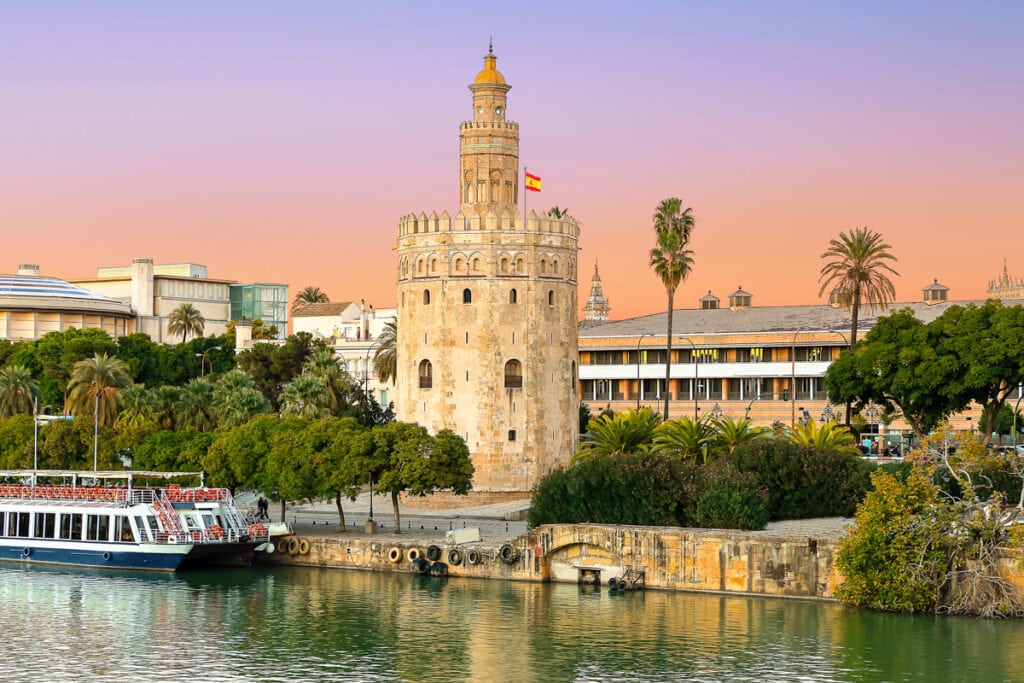
Some links on this page may be affiliate links. If you click an affiliate link and make a purchase, we may receive a small commission, at no extra cost to you. For more details, refer to our disclosure.
In this article…
Winter in Seville Weather
Things to Do in Seville in Winter
Getting to Seville, Spain
Where to Stay in Seville
Tips for Visiting Seville in Winter
Seville Weather in the Winter
Seville has a Mediterranean climate. While it is known for its blazing hot summers, winter weather in Seville tends to be quite mild compared to much of Europe.
Typically, days are sunny and pleasant, while early mornings and late evenings are much cooler.
December and January tend to be the coldest months of the year in Seville, with late November and February a little milder.
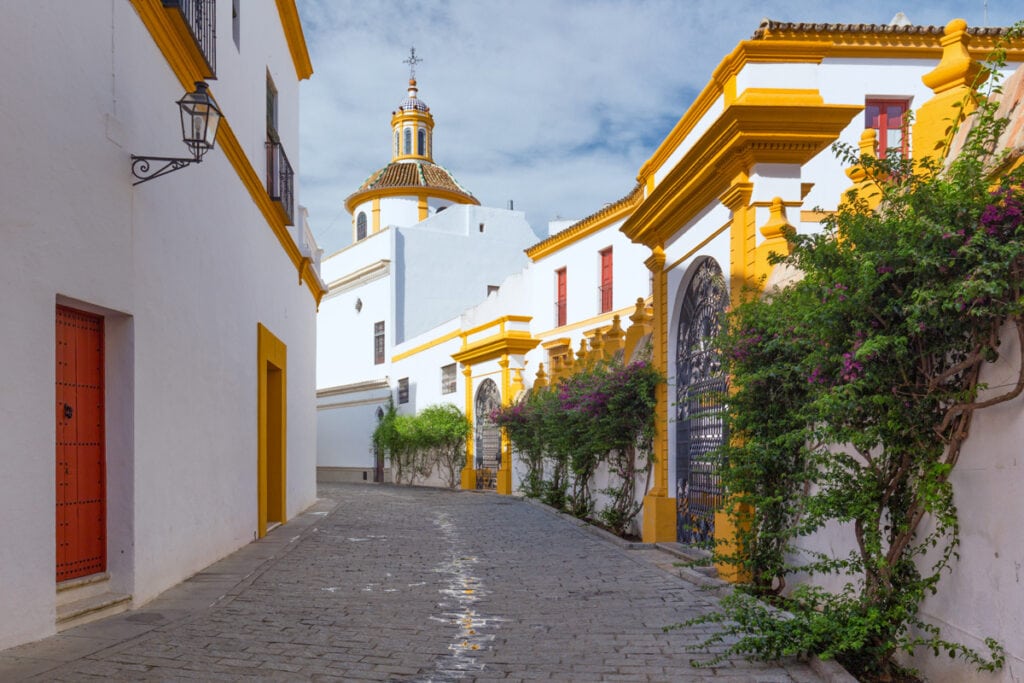
But even the coldest months in Seville typically offer daytime temperatures that are pleasant for wandering the pretty streets and walking through the many gardens!
You can usually lunch outside through the winter in Seville (unless it’s raining, of course), and even enjoy dinner outside by a heated lamp in November and February.
Here’s a table showing the average high and low temperatures in winter in Seville:
| Month | Average High | Average Low |
| December | 62°F (16.6°C) | 45.1°F (7.3°C) |
| January | 61.2°F (16.1°C) | 42.3°F (5.7°C) |
| February | 64.6°F (18.1°C) | 44.6°F (7°C) |
While you may be lucky and get lots of winter sun during your visit, winters in Seville can be occasionally rainy, with about 6 days of rain forecast on average each month.
December is the rainiest month, with 7.5 days of rain and 99mm (3.9 inches) of rain forecast.
While the rain can be a downpour at times, you may also encounter days when it drizzles all day and the skies remain gray and overcast.
Bringing rain gear is a must, but, fortunately, Seville also has a wonderful selection of museums and palaces for rainy days!
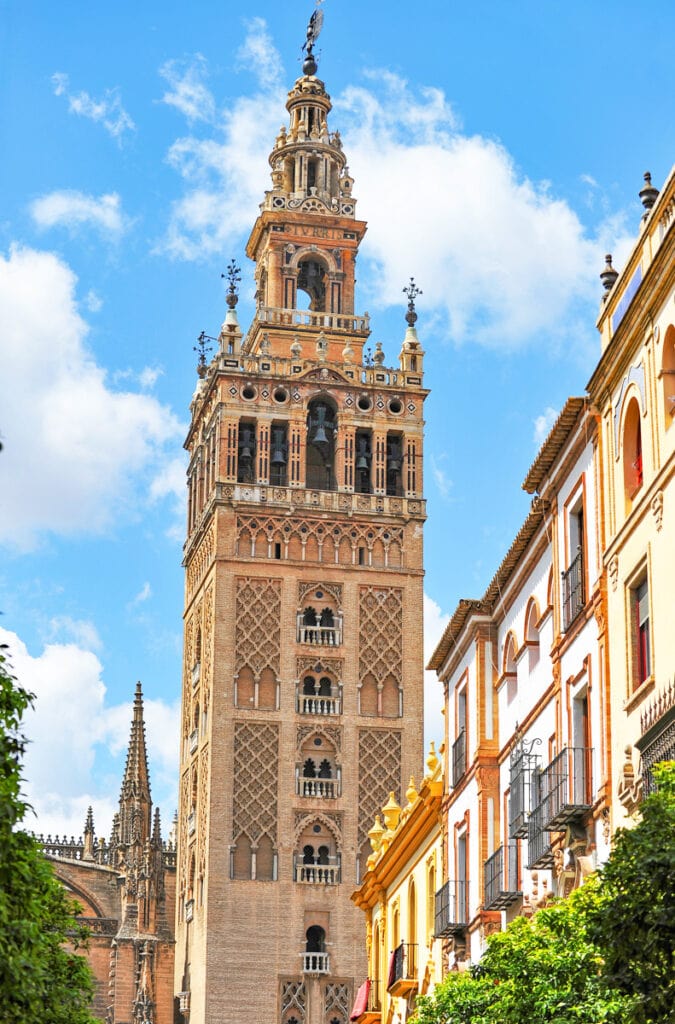
What to Do in Seville in Winter
Many of the best things to do in winter in Seville are the same as you’d do in the spring, summer, or fall, but with fewer crowds.
Seville’s world-famous attractions, like the Alcazar and the Cathedral, which are very congested in the summer, are a joy to explore in the winter. The city is a fabulous destination to include in any winter Spain itinerary.
You’ll also find holiday-related events in December and early January, and hearty winter tapas that make for great comfort food!
Whether you are looking to spend just one day in Seville or you are planning a longer vacation, you will love visiting this lively Andalusian city in the winter!
Here are the best things to do in Seville in winter:
Tour the Royal Alcazar of Seville (without the crowds!)
The Royal Alcazar of Seville is one of our favorite monuments, not just in Andalusia, but in all of Spain.
Known for its gorgeous Mudéjar architecture, Seville’s royal palace was originally built by Islamic rulers and later modified and expanded by Spain’s Catholic monarchs.
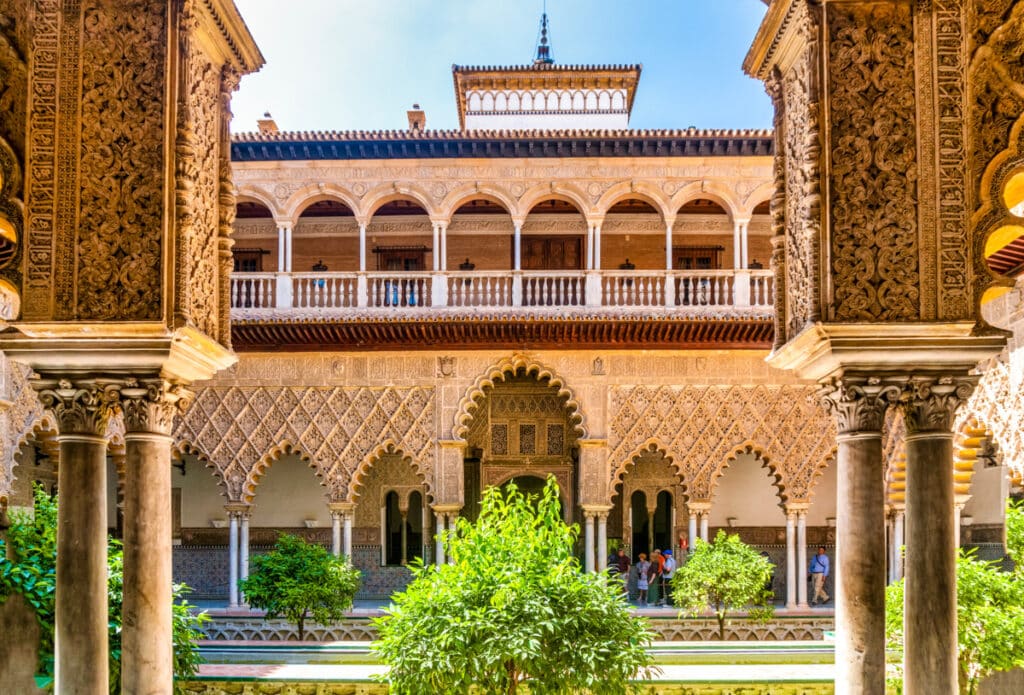
Both the palace and its gardens are stunning, so allow plenty of time!
Gawk at the lace-like arches in the Courtyard of the Maidens, admire the stunning ceiling in the Hall of the Ambassadors, view the magnificent tapestries in the Hall of Tapestries, and visit the Baths of Doña María de Padilla.
In the gardens, snap a photo of the famous Mercury Pond, take in the views of the Galería de los Grutescos, walk through the maze, and admire the orangerie.
The gardens feature many tall palms, lots of greenery that still looks good in the winter, and architectural elements that offer color.
For Game of Thrones fans, the gardens of the Alcazar featured as the Water Gardens of Dorne.
We suggest a guided tour for an insightful experience at the Alcazar. Afterwards, you can wander around on your own if you like, to take in the intricacies of the architecture and the beauty of the gardens at leisure.
Want to visit on your own? Skip-the-line tickets may not be needed in the winter, but we like the comfort of knowing we have guaranteed easy entry to the top sights.
>> Book your tickets for the Alcazar online!
Admire the Seville Cathedral
The Seville Cathedral is enormous. It is one of the largest churches in the world.
The imposing Gothic facade and the art treasures inside make the cathedral one of the best attractions in Seville. And in winter, you can visit without the crowds!
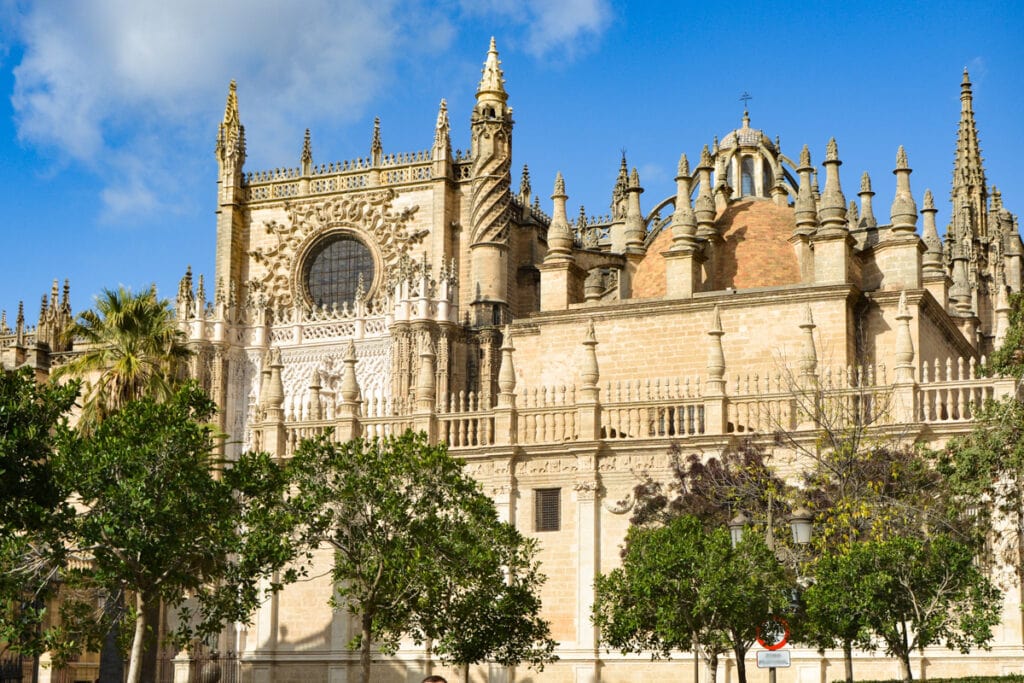
Officially the Cathedral of Saint Mary of the See, the Seville Cathedral, together with the Royal Alcazar and the General Archive of the Indies, makes up Seville’s UNESCO World Heritage Site.
The Seville Cathedral was completed in the early 16th century. The Christians razed the mosque that had stood at the site, in order to build a massive and magnificent structure commensurate with the wealth of the city at the time.
Inside, the nave is the longest of any cathedral in Spain. The interior dazzles with lots of gold, silver, and precious gems, and you’ll find a lot of great religious art, including works by Murillo and Goya.
There are several dozen chapels to view. The Capilla Mayor, the Great Chapel, houses an altarpiece that is literally dazzling, and large. It features scenes from Christ’s life, carved in wood covered with gold.
The Capilla Real is a large and richly-decorated chapel designed to hold the remains of the Castilian monarchs. The cathedral also holds the tomb of Christopher Columbus.
We recommend a guided tour of the Seville Cathedral: there’s so much to see and learn! This popular tour combines a visit to the Seville Cathedral and La Giralda, its bell tower, with a tour of the Royal Alcazar.
Book a guided tour of the Seville Cathedral, La Giralda and the Alcazar now!
If you want to visit on your own, you can buy tickets online in advance.
Take in the panoramas from La Giralda
The graceful bell tower of the Seville Cathedral rises 104m (342 feet) into the sky and is one of the most prominent landmarks in Seville’s historic center.
Originally a minaret for the mosque that stood at the site, La Giralda is named for the weathervane at the top.
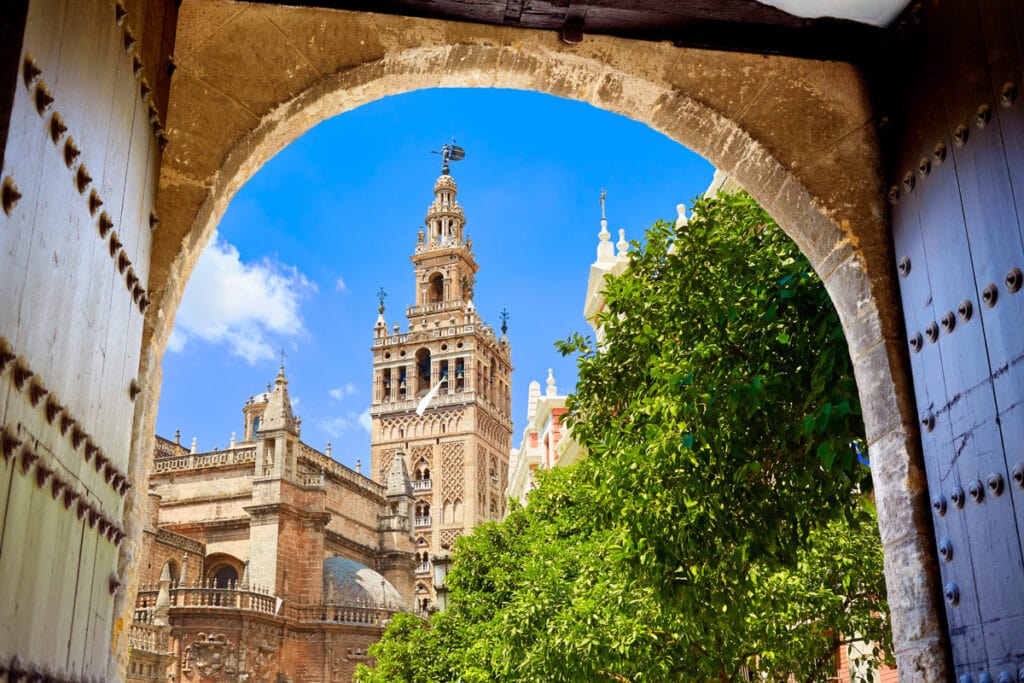
And instead of steps, you walk up 34 ramps to get to the viewing area at the top. There are just a few steps at the very top. It is still a bit of a climb, but easier than all steps.
In the 16th century, the belfry at the top of the tower was added, and now houses the bells.
The 360-degree views from La Giralda over the city are spectacular, and with fewer people in the winter, the ramps are less congested and you can take in the views and snap photos at leisure.
Take a guided tour of the Seville Cathedral and you’ll learn about the history of the bell tower and its architecture from your guide.
If you want to visit on your own, you can buy tickets online in advance.
Wander the Plaza de España
The Plaza de España is not very old: it was built in 1928 for the Ibero-American Exposition of 1929.
The enormous plaza has a focal central fountain, and tall towers at the two ends of a semi-circular complex of buildings at its edge. Four beautiful bridges over a moat allow you to access the buildings.
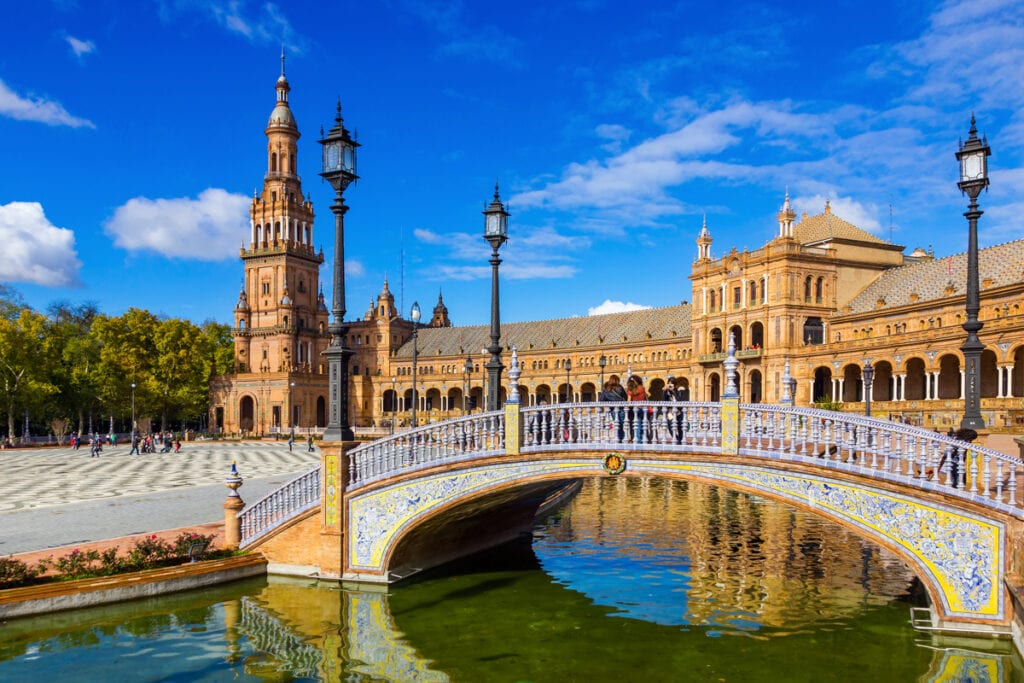
You’ll find lots of intricate tile work at the Plaza de Espana, whether on the sides of the bridges, or along the steps.
But the “must-not-miss” at the Plaza de España are the much-photographed tile alcoves, one for each province of Spain. The details and colors are gorgeous!
Each alcove is edged with covered bookshelves, which locals use as “little libraries!”
On nice weather days, vendors set up stalls for fans and other souvenirs in front of the alcoves, so if you want photos without people in them, arrive early in the day.
Stroll Barrio Santa Cruz
Barrio Santa Cruz is the former Jewish Quarter, and the place where many of Seville’s top attractions, from the Alcazar to the Seville Cathedral, are located.
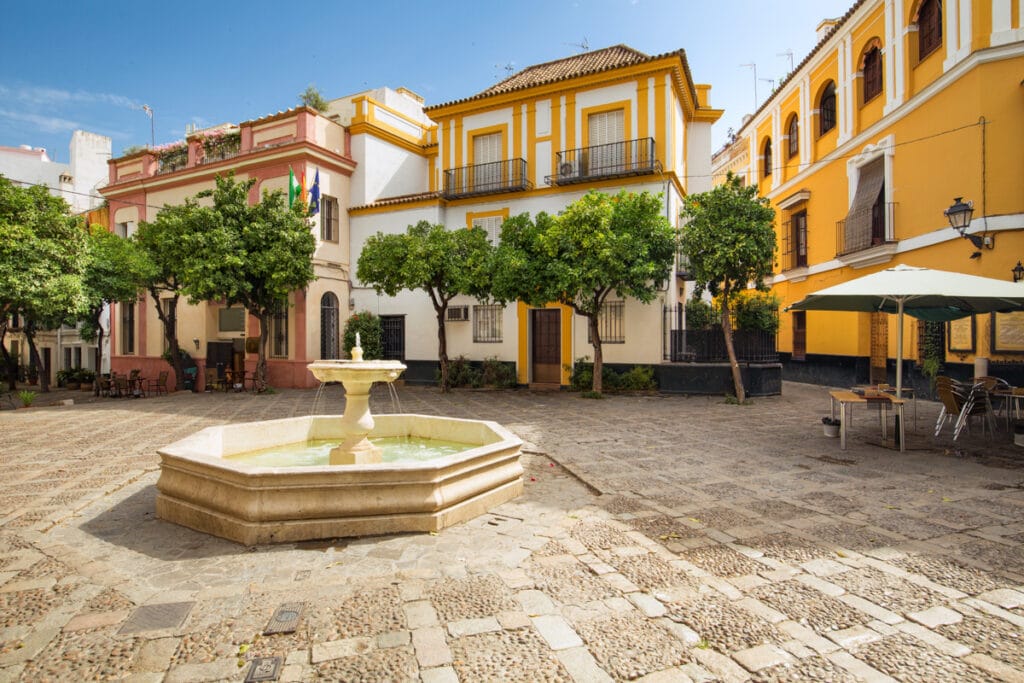
The quarter is a delightful place to wander aimlessly, taking in the pretty architecture, lingering in the plazas, and browsing the many small shops. If you have the time, allow yourself to get lost!
Within the quarter, you’ll find the Casa de Pilatos and the Palace of the Countess of Lebrija, two palaces that are second only to the Alcazar in their beauty.
Snap a photo of the pretty Plaza de Cabildo near the cathedral, admire the building that houses the Archivos de Indias, and pop into the Hospital de los Venerables Sacerdotes, where the small baroque church is stunning.
Visit a Seville Museum
If you do happen to run into some rain on your winter in Seville break, you can take shelter is one of the many fascinating museums in the city!
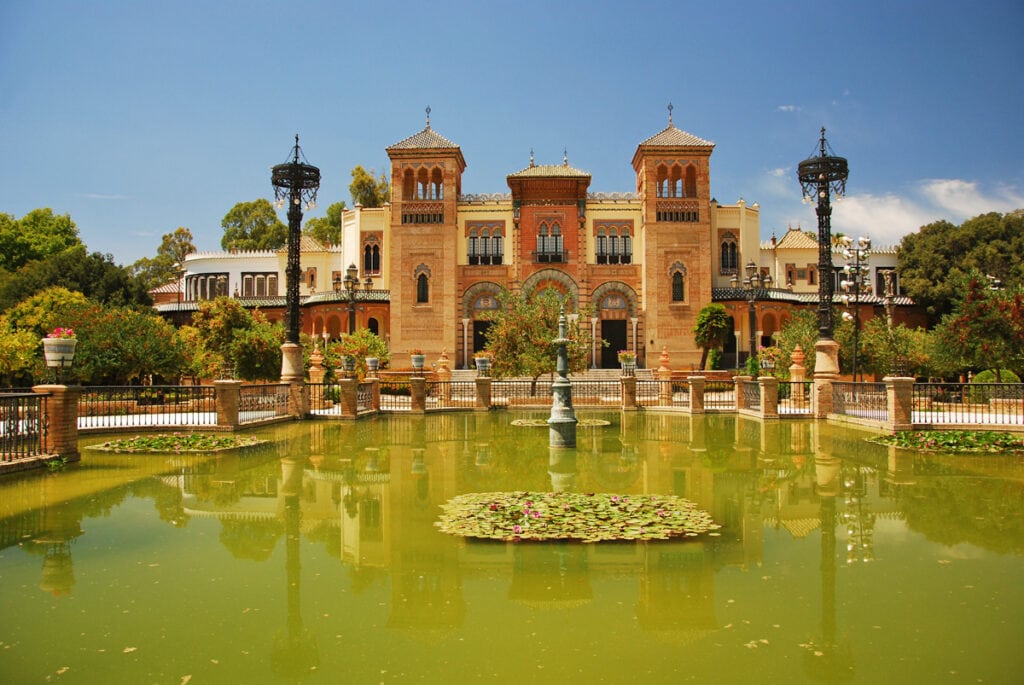
The Museo de Bellas Artes is one of Spain’s major art museums. It has an impressive collection of Spanish art works.
Look for paintings from the 17th century, from “The Golden Age of Sevillian painting.” You’ll find works by masters such as Murillo, Zurbarán, and Francesco de Herrera the Younger.
The building in which the museum is housed is stunning, as are the gardens.
The Archaeological Museum of Seville is one of the museums located in the Maria Luisa Park. Here you will find many of the important finds from Italica!
Look for the replica of “the Treasure of Carambolo,” which dates back to 650 BC! There are old coins, jewelry, and ceramic items.
Just across the street from the Archaeological Museum is the Museum of Popular Arts and Traditions of Seville. The building has a beautiful facade and a water feature, and makes for a great photo.
Inside you will find items from the day-to-day lives of Andalusians in times past: there are ceramics, porcelain, and ivory items, textiles, tools, and household items, and more.
Take in the views from Las Setas
Las Setas, or the Metropol Parasol, is a modern attraction in the Plaza de la Encarnación in the historic center of Seville.
It is a gigantic wooden structure designed by German architect Jürgen Mayer that resembles mushrooms. Hence the name, Las Setas.
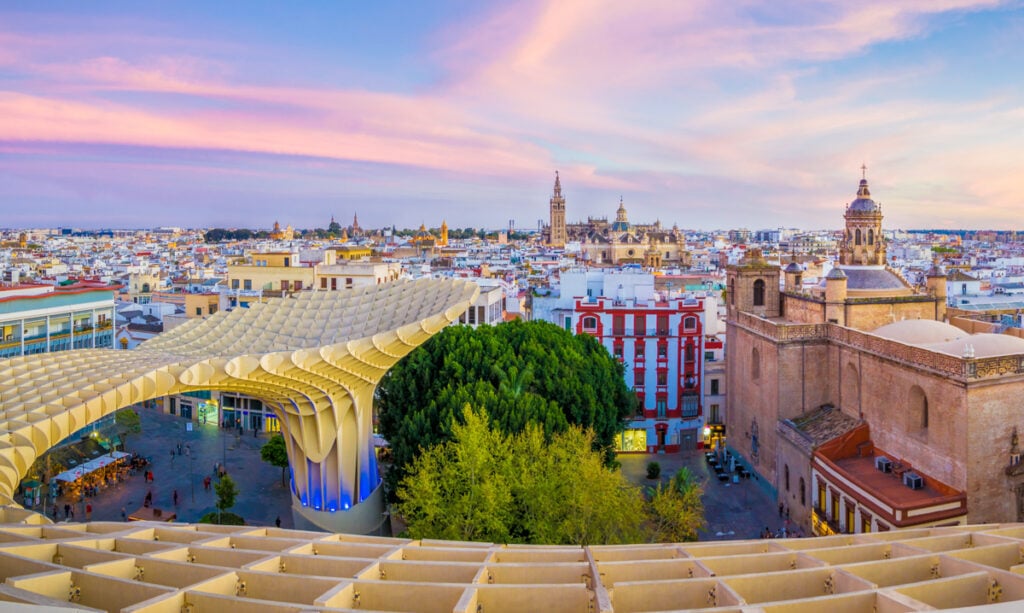
The structure has four levels, and you’ll find shops and restaurants here as well.
At the very bottom is the Antiquarium, where artifacts from Roman and Moorish times discovered at the site are displayed.
The next higher level is the open plaza, where the mushrooms loom over you and offer shade.
The top two levels have terraces with panoramic views of the city. Walking the pathway along the upper level is fun!
Come here for a drink at one of the restaurants and a stroll along the terraces at sunset. You can stay to watch the mushrooms light up, too.
Walk around Triana
Located on the west bank of the Guadalquivir, the Triana neighborhood has a charm all its own. It is known as a center of azulejo and pottery production, and for flamenco.
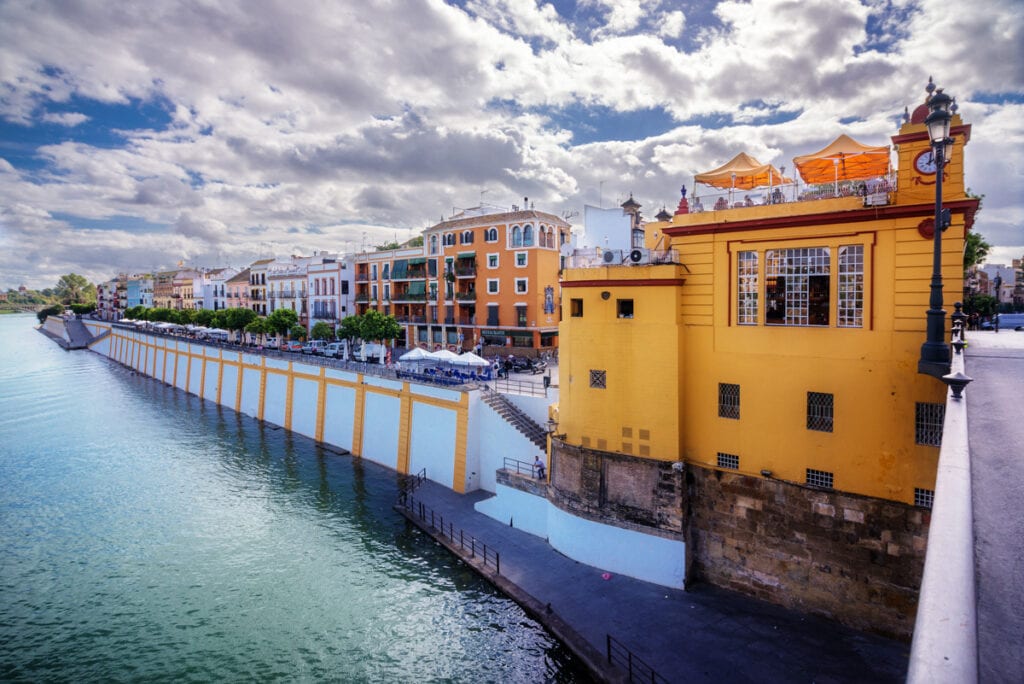
Walk over the Puente de Triana to explore this quaint part of Seville. As soon as you cross, you will see the Capila del Carmen, with its colorful tiled dome.
Also right by the bridge you’ll find the Mercado de Triana, where you can admire the fresh produce and foods in the stalls and pick up fresh fruit, cheeses, jamon, and more.
Wander the narrow streets and admire the churches and other monuments. From Calle Betis, you get great views of the Torre del Oro and the river edge of Seville’s historic center across the Guadalquivir River.
Shop for some tiles or ceramic pottery to take home, and stop by the Centro Ceramica Triana, the museum of ceramics.
Take an excursion to Italica
One of the first Roman settlements in Spain, Italica was founded in 206 B.C. and is reported to be the birthplace of Roman emperors Trajan and Hadrian.
Today you can tour the well-preserved archaeological site, located in Santiponce, about 10 km (6 miles) from the Seville center.
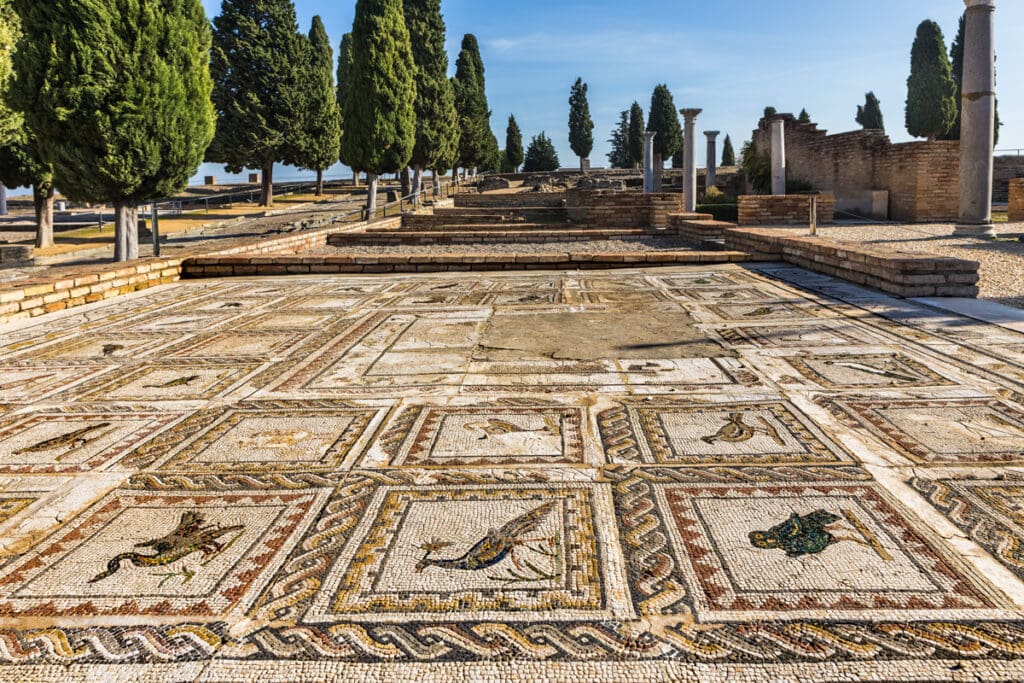
Winter is a fine time to visit, since daytime temperatures are mild. The site is fully exposed and tends to be unbearably hot in the warmer months of the year.
The amphitheatre at Italica is gigantic and the most impressive sight to explore. Also of note are the mosaic floors from some of the villas: many of them are still close to intact.
Italica served as a filming location for Game of Thrones: it was the setting for the Dragonpit.
To visit the site independently, take the local bus from the Plaza de Armas bus station. You can also do a 4-hour guided tour from Seville.
Enjoy a flamenco show!
Flamenco is believed to have originated in Seville, so what better place to take in a performance of the exciting dance form?
The flamboyant costumes, mesmerizing music, fancy footwork, and passionate expressions that make up the flamenco art form combine for a memorable evening.
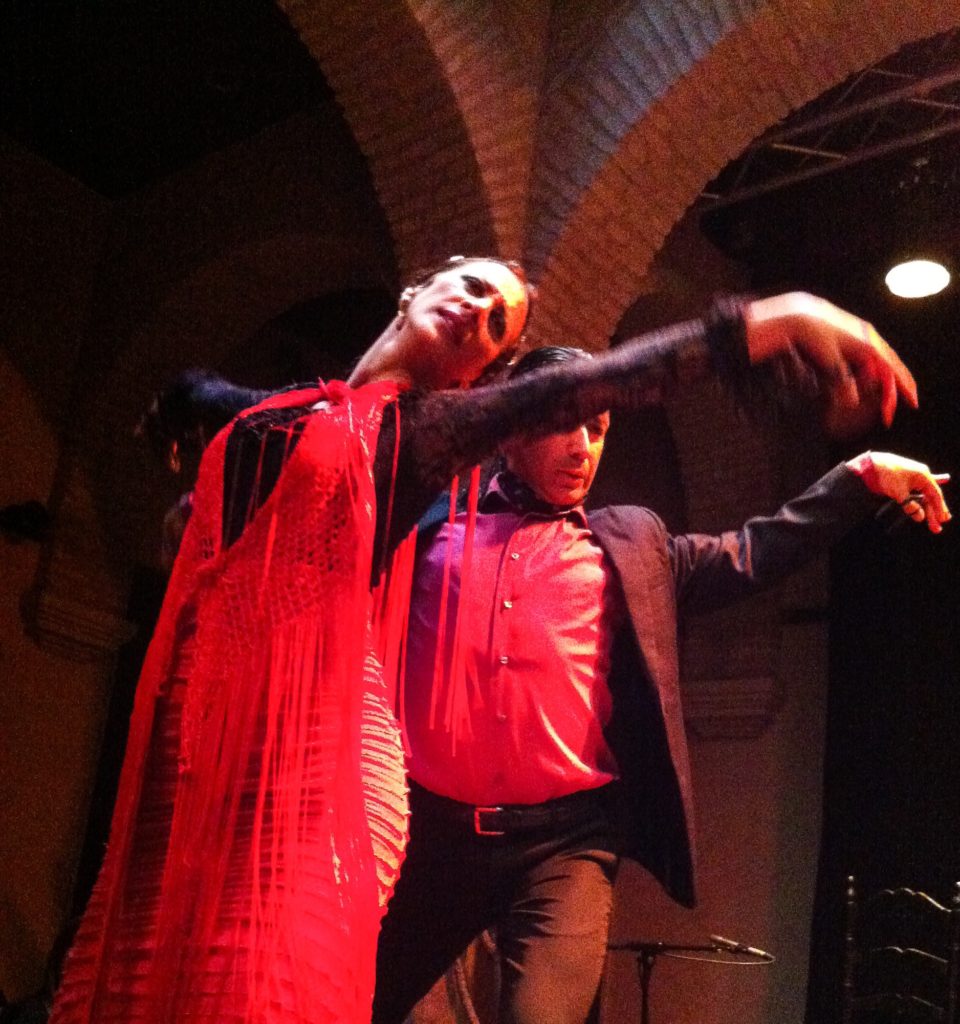
One of the best places to watch flamenco in Seville is the Museo del Baile Flamenco. While you can tour the museum to learn more about the art form, you can also just go for the show.
The Flamenco Museum is where we saw our first flamenco performance and it was fabulous. Book tickets!
Another popular venue is the Casa de la Memoria, which is not a super small intimate venue but still considered one of the best flamenco experiences in the city.
Tablao Flamenco El Arenal is a bar setting, and the food and service are very good. The flamenco show here is rated one of the best in Seville.
And finally, in Triana, the Baraka Sala Flamenca Triana Tablao is hugely popular. The setting is intimate, so if you have a good seat, you can see the expressions on the dancers’ faces and watch their feet from not too far away.
Eat lots of tapas
Seville is a fabulous destination for foodies, no matter the time of year, but winter is the perfect time on gorge on tapas that are hearty and comforting.
Seville’s many tapas bars look especially inviting and cozy on cool winter evenings. A tapas crawl is a must on any Seville itinerary!
Try the super popular traditional spinach and chickpea stew, piping hot and full of flavor. Or pork loin with whisky sauce. Or pork cheeks in a wine reduction. Stuffed mushrooms, and meatballs, are more options.
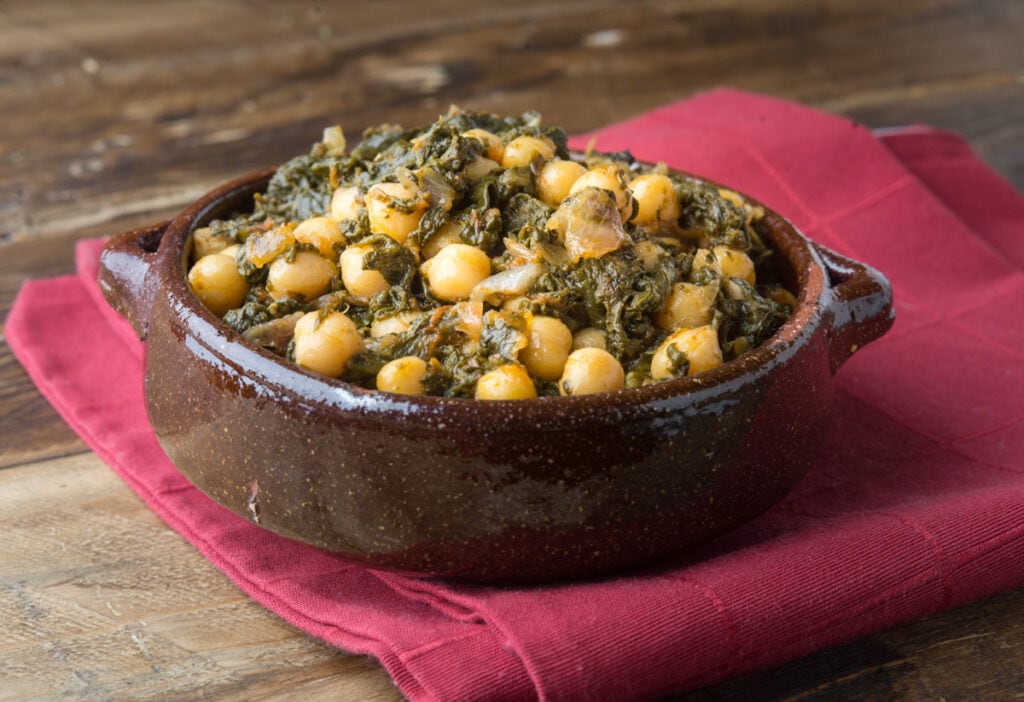
Whether you enjoy them with a glass of Rioja or a can of beer, Seville’s tapas will have your tastebuds dancing with joy.
Eslava is one of the most popular tapas bars in Seville, so you might have a wait, even in the winter. But the food is well worth the wait. Try the egg yolk on boletus cake, their most famous creation. Save room for dessert.
Rinconcillo is a historic tapas bar, dating back to the 17th century! The pork cheeks and the spinach with chickpeas here are delicious and authentic. Also try the beer-battered codfish.
Want to do a guided tapas crawl? On this well-reviewed 3-hour evening tour, a local foodie guide takes you to five different tapas bars for tapas tastings, dessert, and drinks. You’ll learn about the city’s gastronomy history and culture as you walk.
Book this Seville tapas crawl now!
Do a day trip to Cordoba
Cordoba makes for one of the most exciting day trips from Seville any time of the year, but winters in Cordoba are mild, just as they are in Seville, making Cordoba a particularly ideal winter day trip.
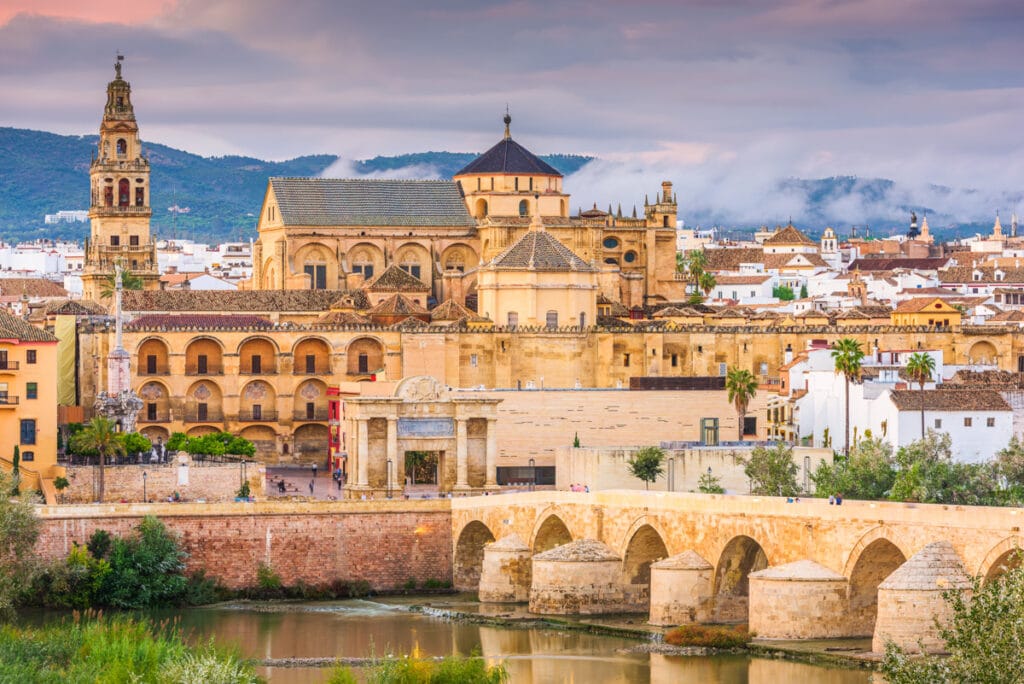
In Cordoba, make a beeline for the magnificent Mezquita, Cordoba’s famous mosque-cathedral.
The hundreds of candy cane arches will stop you in your tracks, but also admire the dazzling mihrab and the highly-decorated cathedral ceilings. Climb the bell tower for panoramic views!
A guided tour of the Mezquita is a worthwhile expense: it’s a much more enhanced experience, and you can stay back after the tour and wander around on your own if you want to take more photos.
Wander the narrow alleys of the Jewish Quarter, where the synagogue is well worth a stop. Admire the statue of Maimonides, and snap a photo of Calleja de las Flores, where you may find flowers in the pots blooming even in the winter.
Walk the Roman Bridge (it featured as a location on Game of Thrones), and visit the Alcazar, especially for its gorgeous gardens.
The high-speed train from Seville to Cordoba takes only about 40 minutes, so you’ll have time for sightseeing on a Cordoba day trip in the winter, even though daylight hours are short.
Book train tickets for Seville-Cordoba ahead of time on Omio, or join a guided tour from Seville!
Visit Seville’s Christmas market in December
December is a festive time to visit Seville!
The air is crisp and the aroma of roasting chestnuts wafts in the air.
You’ll find illuminations, caroling and pockets of dancing on the streets, beautifully decorated shop windows, and Nativity scenes in many places in the historic center.
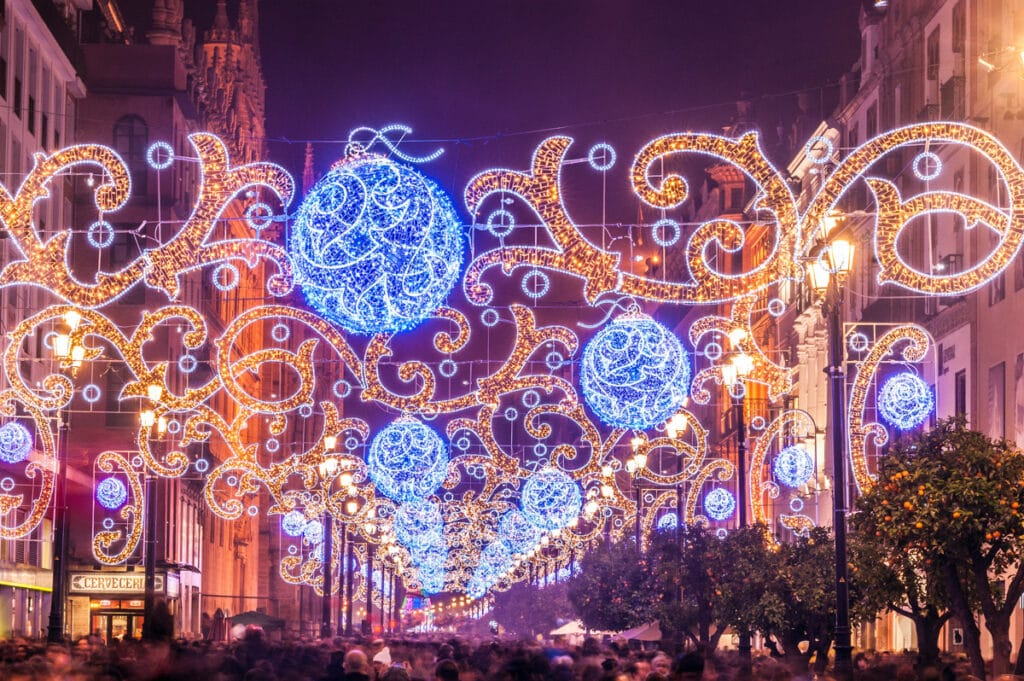
The Nativity scenes are breathtaking, well worthy of a dedicated stroll to seek them out. They often feature the entire town of Bethlehem, not just the manger.
There are at least two outdoor Christmas markets of note to visit in the historic center of Seville.
The Feria de Artesania is held in the Plaza Nueva, and features traditional Andalusian arts and crafts. There are several dozen stalls with beautiful handcrafted gifts and decor items, from ceramics to wooden toys. They make for unique souvenirs!
The Feria de Belén is held near the Seville Cathedral, and features over two dozen stalls with handcrafted holiday items, especially belén figurines.
Join the celebration on New Year’s Eve!
Sevillanos party into the wee hours on Nochevieja, New Year’s Eve, so if you are up for it, you can party the night away too!
Stake out a spot by the river or head to a rooftop terrace bar to watch the New Year’s Eve fireworks.
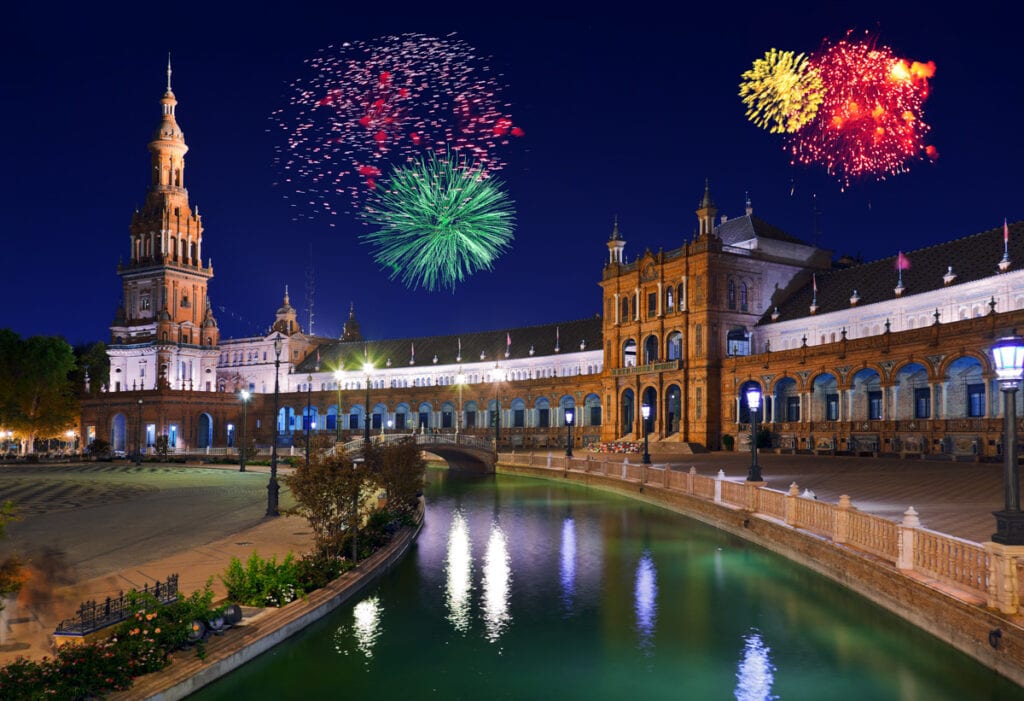
Before midnight, head to the Plaza Nuevo, with twelve grapes (!), for the traditional Spanish ceremony of ringing in the new year.
As the clock chimes the twelve strokes of midnight, pop one grape into your mouth for each stroke, until you’ve eaten all 12 grapes. It’s harder than it seems!
Many Seville hotels have New Year’s Eve celebrations. Splurge on the festive New Year’s Eve gala at the historic Hotel Alfonso XIII, where you can enjoy a superb multi-course meal and fine wine.
To end the night on a sweet note, stop for a treat of chocolate con churros on your way back to your hotel.
Celebrate Three Kings’ Day in January
Dia de Los Reyes Magos, or Three Kings’ Day, is celebrated on January 6. From a traditional perspective, this is the day children in Spain receive their Christmas gifts, and it’s the Three Kings that deliver them.
The arrival of the three kings into the city is marked with a fun parade each year on January 5. The parade, known as La Cabalgata de Los Reyes, winds through the streets over several hours.
Thousands of people line the streets to watch the colorful floats and carriages. Musicians and dancers in costume perform, and the three kings and their attendants throw candy into the crowds. It’s great fun to watch, if you are okay with crowds.
On January 6, be sure to visit a local pastry shop to get a roscón de Reyes to have with Spanish hot chocolate! The once-a-year dessert is a round or oval brioche-like bread, with a filling of sweet cream and topping of dried fruits and chopped dates.
Enjoy the scent of citrus blossoms in February
Seville is known for the orange trees that line the streets of its historic core and dress up its courtyards. There are about 40,000 orange trees in the city!
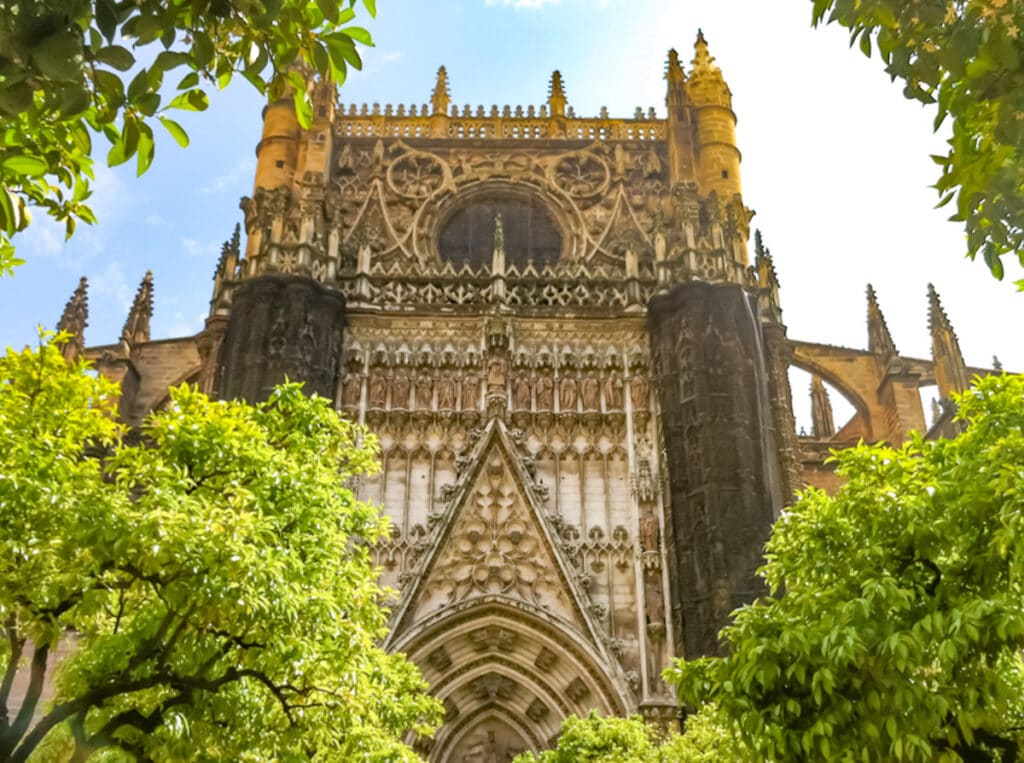
The oranges are bitter oranges, used in medicine and to make perfume, liqueurs, confections, and marmalade. They can’t be eaten fresh.
The trees stay green and lush year-round, the dark green leaves providing a contrast to the orange fruit and the white blossoms.
If you visit Seville in the second half of February, you may get the whiff of citrus blossoms as you walk the streets! By the end of the month the azahar — orange blossom fragrance — is heady!
Getting to Seville, Spain
Seville has an international airport, with flights from several cities in Europe. the airport is located about a 15-minute drive from the historic center.
Seville has an international airport, with flights from several cities in Europe. the airport is located about a 15-minute drive from the historic center. You can book a transfer to the city center, or take a taxi or the local bus.
Seville is also connected by high-speed train with other major cities in Spain, including Madrid (2 hours and 23 minutes), Barcelona (5 hours and 33 minutes), and Malaga (2 hours and 14 minutes).
From the train station, the city center is less than 3 miles, and you can either take a local bus or a taxi, or book a transfer.
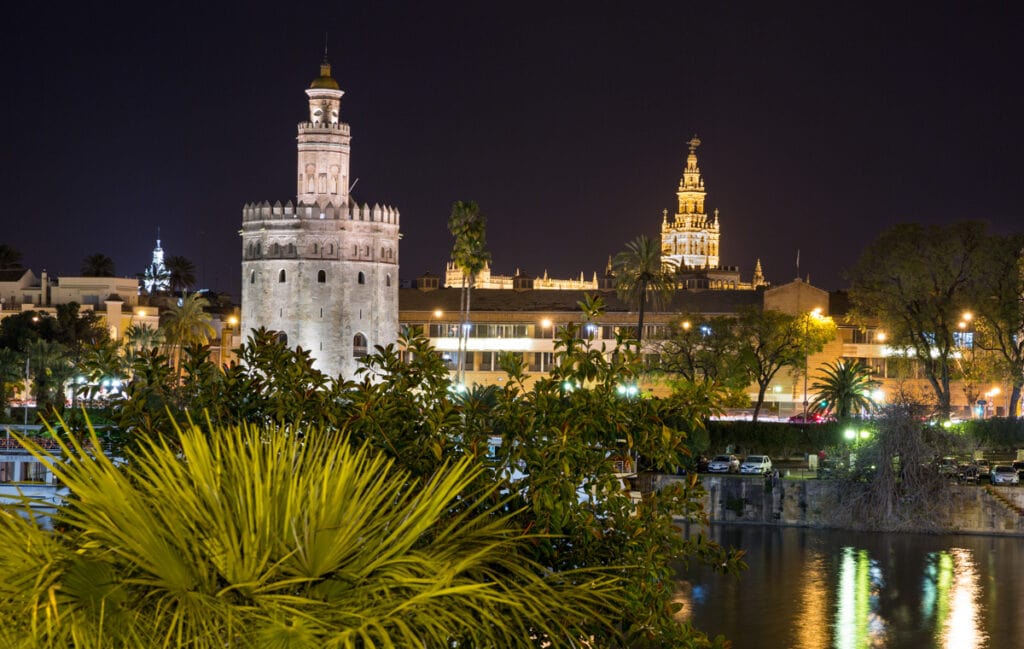
Where to Stay in Seville, Spain
LUXURY
Hotel Alfonso XIII is one of Spain’s top hotels, and winter is a great time to stay here, because the prices are much lower than during the high season. It is located near the Royal Alcazar, on the fringes of Barrio Santa Cruz.
Rooms are elegant and luxurious, while the public spaces and courtyard (with fountain!) are drop-dead gorgeous. An onsite restaurant serves traditional Andalusian cuisine in the courtyard. Enjoy drinks and tapas at another eatery on the outdoor terrace.
Hotel Colon Gran Melia is located in El Centro, about 0.5 mile from the Seville Cathedral. We had a superb stay at this hotel on our first visit to Seville, and walked to most sights. The rooftop pool is heated!
Rooms feature individual decor, and the bathrooms are well-appointed. Some rooms have patios or balconies. The hotel offers a hot tub and a rooftop terrace. Breakfasts are highly rated.
Mid-Range
Hotel Becquer is located by the Guadalquivir River, just a few minutes’ walk from major sights like the Seville Cathedral and the Real Alcazar. It’s a wonderful haven to which you return after a day spent sightseeing.
Rooms feature super comfy beds and unique art, and some rooms have views over the city. The breakfast buffet is highly rated.
Budget
Simon Hotel is located in an 18th century mansion close to the Seville Cathedral. While very convenient for sightseeing, the hotel’s location is quiet.
Rooms are comfortably furnished and air-conditioned. Some rooms feature traditional Andalusian decor. The central courtyard, where breakfast is served, is lovely.
Tips for Visiting Seville in Winter
DRess in layers!
If you start your sightseeing early in the day, you’ll want to dress warm. You’ll also need a warm jacket or thick sweater for the evenings.
But during the day, you may find it pleasant enough for a long-sleeved thick-ish top, so dress in layers that you can peel off or put on as the weather demands.
A stylish beanie and scarf are also great to bring!
Expect rain
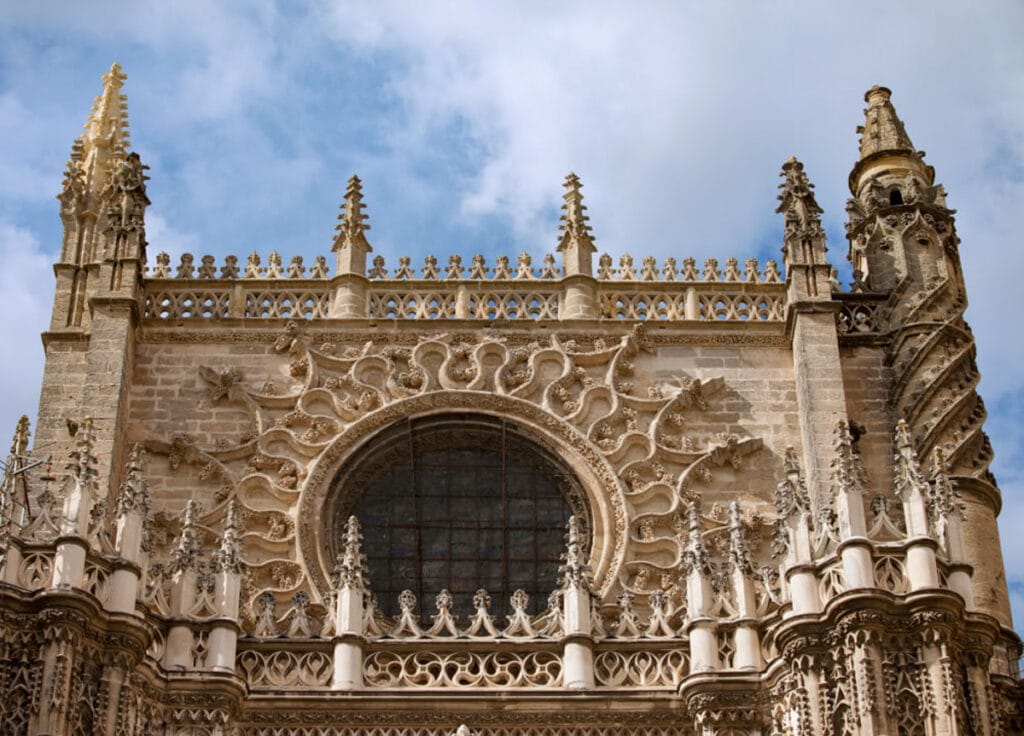
Hopefully you’ll have lots of sunny days on your winter Seville trip, but have a plan for rain, just in case!
Stash a sturdy umbrella in your day bag, and plan on popping into a museum or palace to ride out heavier rain.
If you find that the forecast calls for a fair bit of rain, consider a Hop On, Hop Off bus to get to sights further away, to reduce the amount of walking on wet streets.
And mind your step, the streets and alleys can get slick and slippery in rain.
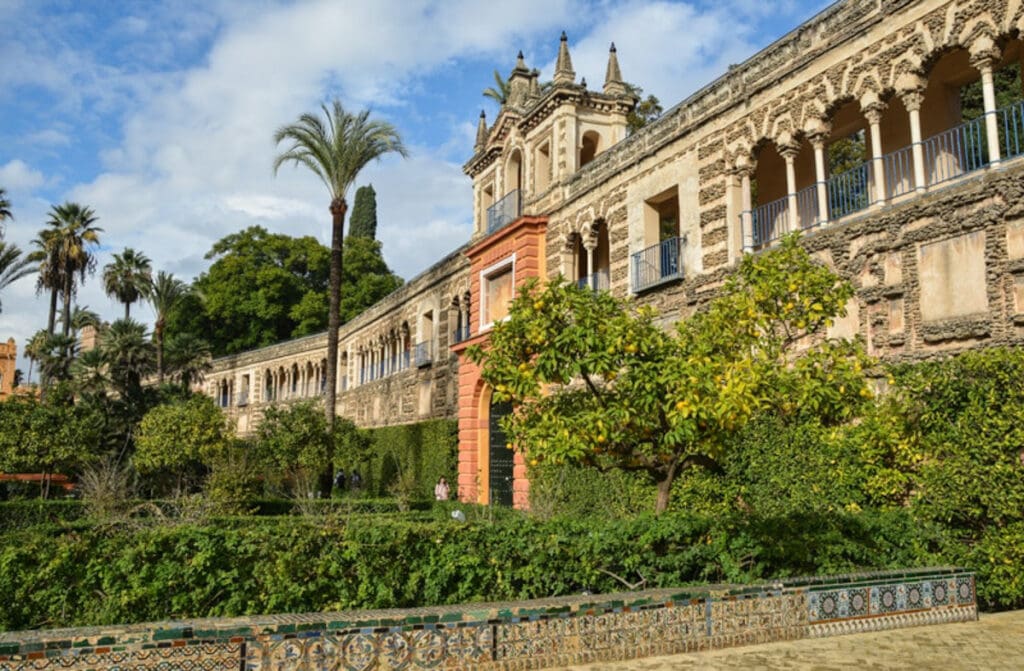
Plan for shorter daylight hours
Winter in Seville means lower crowds and shorter lines at popular sights, but keep in mind that daylight hours are short in the winter months and it gets dark early.
Allow for enough days in Seville to visit the sights you’ve set your heart on visiting. Three days in Seville is a good amount of time, but more is always better: more time will allow you to slow down and savor the vibe that’s such an integral part of the city.
Start your days as early as you can, to maximize your sightseeing time, especially if your time in the city is limited.
Wear shoes with good grip
We recommend good walking shoes or boots with good grip, since streets and sidewalks can get slick with rain. Make sure to break them in before your trip!
And waterproof footwear is a good idea. We were caught in a downpour on our first visit to Seville (in the spring), and the water soaked right through…not a pleasant experience.
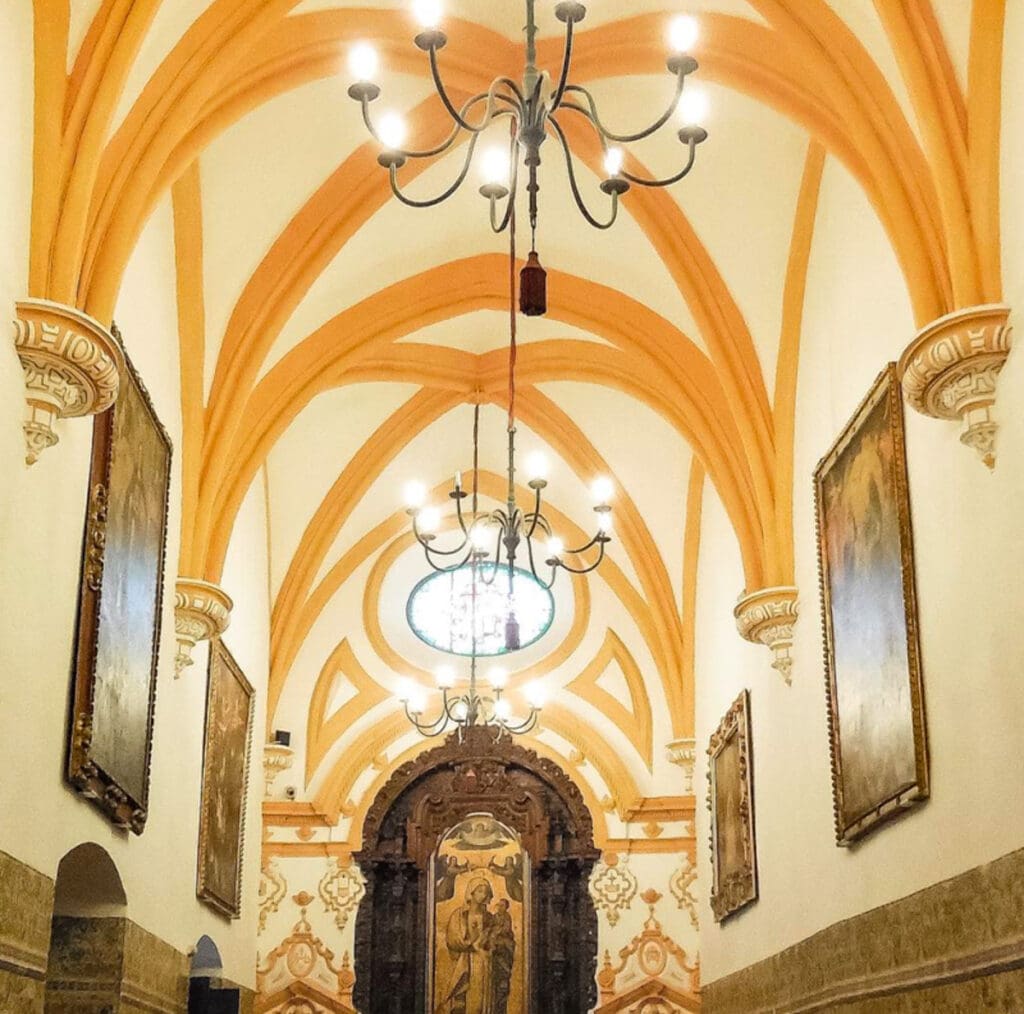
Make sure your accommodation has heating
Nights do get cold in winter in Seville, so read the fine print when you book your accommodations, to make sure you have heating! Most places do, but it does not hurt to check before you book.
Some hotels offer heated winter pools, so look for that if it’s important to you.
Buy train tickets in advance
This suggestion holds good no matter which time of year you visit Seville!
If you are planning to visit more than one city on your Spain trip, look into booking high-speed train tickets ahead of your trip to save some money.
Spanish train travel ticket bookings open 60 days in advance, and AVE high-speed train bookings can open 90 days in advance.
Longer-distance train routes in Spain may even require that reserving your seat in advance, so be sure to check your planned travel routes, instead of just showing up at the train station on the day of travel.
We use Omio to book train travel in Europe. The website is in English, and we’ve never had an issue with our bookings getting processed, so we gladly pay the small booking fee for the convenience.
Renfe is the official train company in Spain, and you can also book on their site, but be warned, it can be clunky and a hassle to navigate, and they may reject some credit cards, especially US cards.
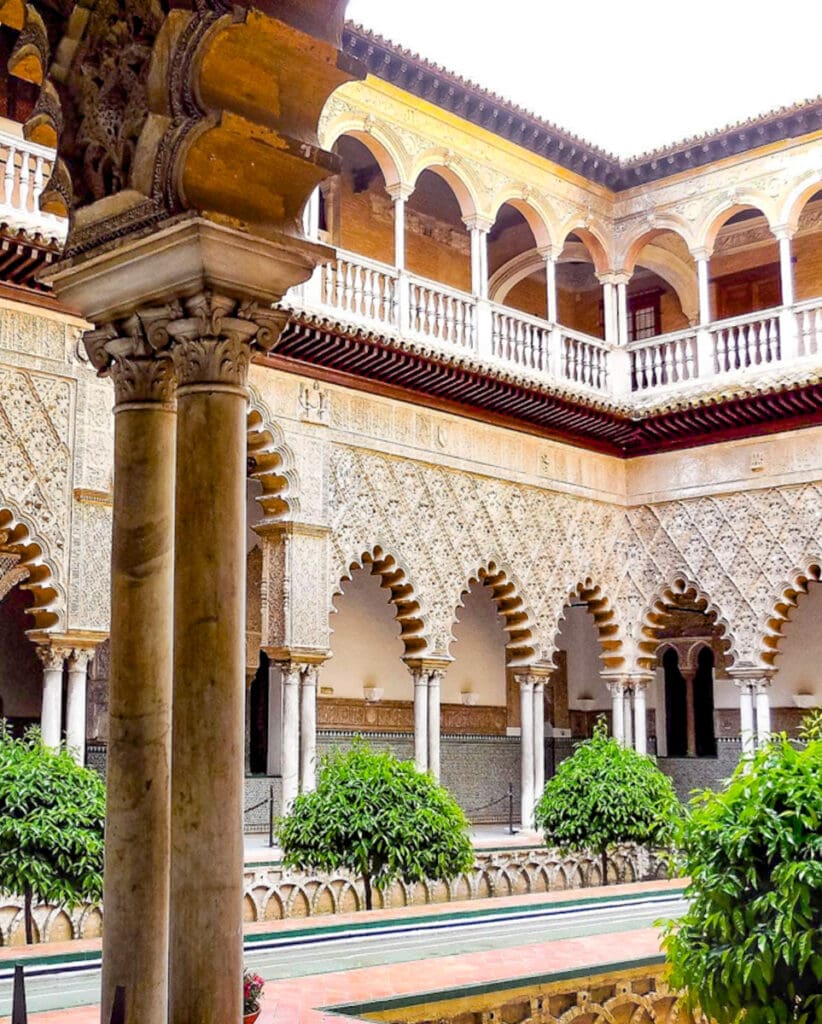
Expect delays
Although winter in Seville is mild, it’s still winter, so it’s good to be prepared for weather-related delays, whether you’re doing inter-city travel or taking a day trip.
Traffic may be slower in the rain, so give yourself enough time to arrive at the airport or train or bus station.
Have some cash handy for warm drinks and snacks
Whether you want to enjoy some roasted chestnuts from a street vendor in December, or get some chocolate or churros to go, keep some small bills handy. You never know when the sight of a warm street snack will entice you!
You will also need cash at the Christmas markets, if you plan to eat or drink at a stall, or buy souvenirs to take home.
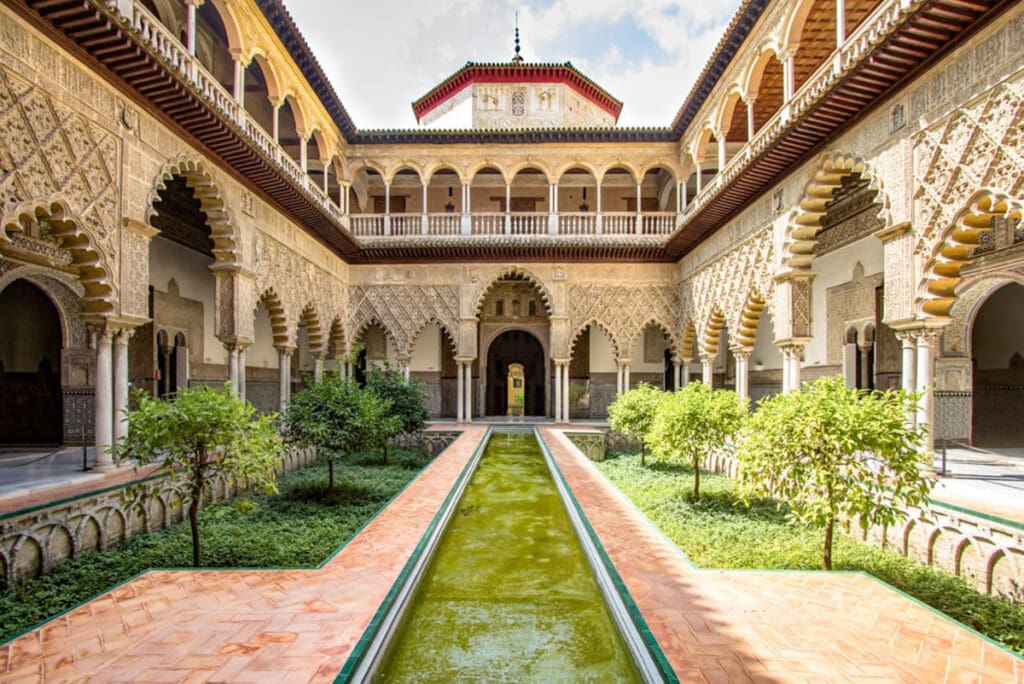
What to Pack for Winter in Seville
An anti-theft day bag or back pack is a must any time of year, so you can walk around with your hands free and your valuables safe. We never travel to Europe without our crossbody bags: we use this one and this one.
Pacsafe has a variety of backpacks and day bags for both women and men. Check prices on Amazon!
Travel adapters are, of course, a must! This highly-rated adapter charges several devices simultaneously, and we’ve used ours on several trips to Europe without issues.
If you’re like us, you’ll be taking lots of photos and videos with your smartphone, so stay charged through the day with a portable charger.
A sturdy umbrella that fits easily into your day bag or backpack is essential for a winter trip to Seville. We like this umbrella, because it’s compact and light yet wind-resistant: it won’t flip over!
Sunscreen is a must-bring, because you’ll be wandering around outdoors quite a bit, and although you’ll be visiting Seville in winter, the Spanish sun can be very much in evidence!
Two other items to remember for a winter trip are lip balm and skin moisturizing lotion.
And of course, do not forget to bring some hand sanitizer!
Did you find this article informative? Pin it for later reference!
